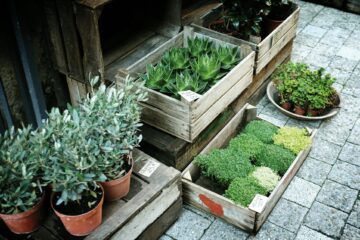The clocks are going forward, which means it’s time to get out into the garden. Now that winter is over you can start doing some essential spring time gardening jobs around your home, including tidying away winter debris, cutting back perennials and shrubs, pruning fruit trees and bushes and raking up leaves.
Spring time gardening job no. 1: tidy away winter debris.
After the winter, it’s time to tidy up your garden. Remove dead leaves, twigs and other debris from the garden. If there are diseased woody plants in your garden (for example, trees), consider removing them as this can help prevent diseases spreading on to other plants.
If you have any plants that are diseased or dead, remove them from your garden. This can help prevent the spread of disease onto other plants.
Cut back perennials and shrubs.
Cut back perennials to about 5cm from the ground.
If you’ve got a lot of shrubs and roses in your garden, it’s best to wait until you see new growth before cutting them down. This will help prevent bleeding or stress on the plant as well as encourage healthy growth. If you have plants with prickles like hollyhocks or delphiniums, don’t cut back until they flower on old wood (see below).
Trim spring-flowering shrubs such as forsythia, buddleia, lavender and viburnum.
Trim spring-flowering shrubs such as forsythia, buddleia, lavender and viburnum.
You can also prune later in the year but it is best to do it now while they are still dormant. Trim back to the first flush of growth using hand shears or secateurs (hand pruners).
Prune fruit trees and bushes.
- Prune fruit trees and bushes.
- Prune in spring to promote new growth, maintain shape and size and remove dead or diseased wood.
- If you have a walled garden, be sure to keep the walls tidy by removing old plant material from them with secateurs as soon as it has finished flowering or fruiting.
Rake up leaves, cut back branches and remove any moss.
- Rake up leaves, cut back branches and remove any moss.
- Do this in the spring.
- Why it is important to do this in the spring: If you don’t rake up your leaves and cut back your branches now, they will make it hard for you later on when you want to garden.
How do I do it? If there are a lot of leaves on the ground (or if you have trees), use a lawn mower first before raking them up so that they’re smaller pieces when you sweep them into piles with a broom or shovel. Then rake them into piles along with any other debris like twigs or sticks that need removing from around your yard.*
An essential spring time gardening job is to look after the soil in your garden.
Loosen the soil in your vegetable beds with a fork or spade so air can penetrate it and water can drain freely during the wet summer months. A light dressing of compost over the surface will help keep plants healthy by improving soil structure, retaining moisture, encouraging earthworms and adding nutrients to plants’ roots as they decompose.
Loosen the soil by hand if you have time – this will speed up drainage and improve aeration for next year’s crop (it also makes it easier for you!). If you don’t have time, use a rotary tiller or broadfork to loosen up clumps of earth before adding any compost; otherwise you’ll end up with an uneven spread that doesn’t benefit your garden as much as if all parts were equally aerated.
Compost needs plenty of oxygen while it breaks down into humus – add around 5cm-10cm (2″-4″) every year until there is enough depth (15cm+/6in+) so that worms can work their way through easily without disturbing too much topsoil when they come out at night looking for food!
Spring time is right for all the jobs gardeners have been putting off until now!
Spring is the perfect time to tidy up your garden.
Perennials that have grown out of control can be trimmed back. If you’re not sure how much to cut, remember that it’s better to remove too little than too much. You can always trim again later if necessary. Also make sure you don’t cut into any flower buds or growth points on shrubs and trees – these will produce flowers next year!
Shrubs can also be pruned at this time of year – but only if they’ve been dormant for several months (the same goes for fruit trees). The best time for this job is just after they start growing strongly again in springtime; once they’re established, it’s better not to prune them as this will weaken their growth habit over time – so now’s your chance!
If there are any diseased branches on trees or bushes, now is also an ideal opportunity to remove them before they spread further around the plant: simply cut off any dead wood with secateurs then dispose of safely by burning it outside–never throw away diseased parts near other healthy plants where insects may pick up spores from them!
So, get out there and start digging! You’ll soon be enjoying the fruits (or vegetables) of your labour.
Keep on top of your gardening with our free online journal
Our free online tool allows you to organise your ideas and garden plans and help you be as efficient as possible in the garden.
Sign up now

